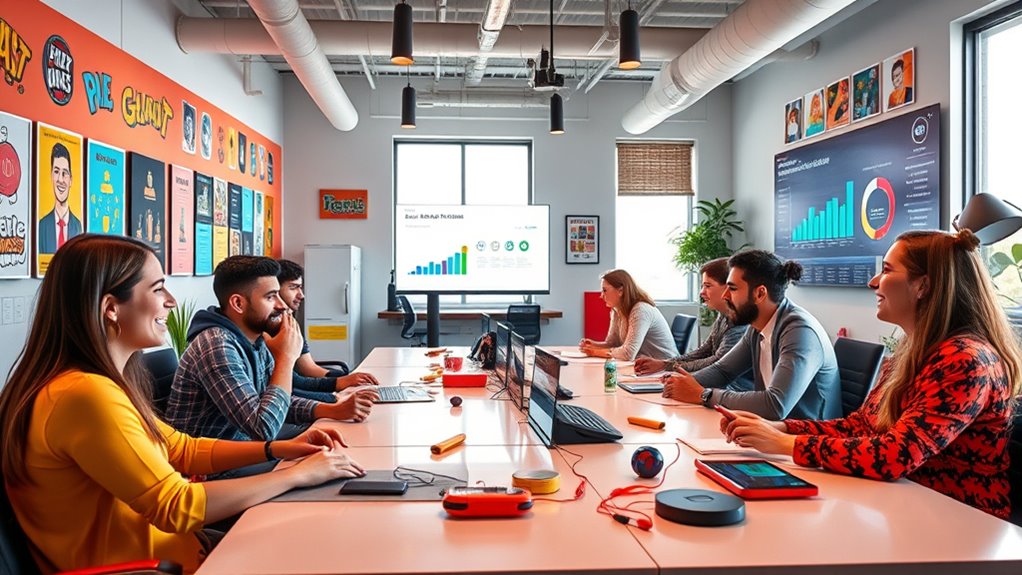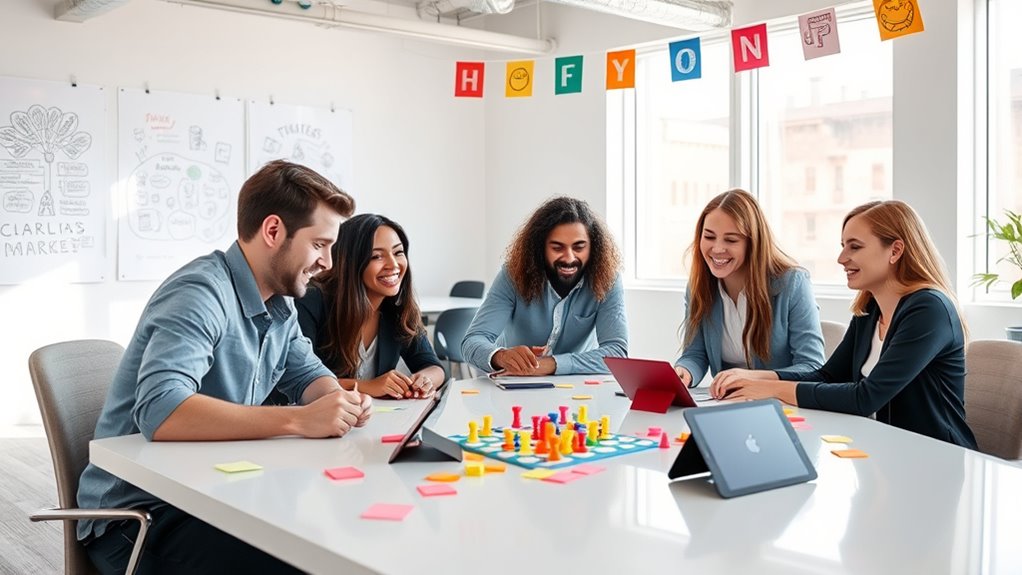To energize your company culture through play at work, consider gamifying your innovation processes. Instead of relying solely on traditional methods, add game elements like points, badges, and leaderboards to make idea generation engaging and inclusive. This approach encourages participation, reduces fear of judgment, and creates a safe space for diverse contributions. By making innovation fun and transparent, you foster ongoing collaboration and creativity—discover how to transform your workplace into a vibrant hub of continuous innovation.
Key Takeaways
- Gamification transforms idea generation into engaging activities, boosting employee motivation and fostering a culture of continuous innovation.
- Incorporating game elements like points and leaderboards encourages ongoing participation and recognizes contributions.
- Creating a safe, inclusive environment reduces fear of judgment, broadening participation across all team members.
- Transparent tracking of ideas and rewards promotes accountability and demonstrates tangible results, energizing the workplace.
- Using skill-based mechanics, such as Pinball-inspired systems, makes innovation activities dynamic and fun, inspiring creative collaboration.

In today’s fast-paced workplaces, traditional methods of fostering innovation often fall short. Relying solely on meetings, suggestion boxes, or top-down directives can leave your team disengaged and stifles creative thinking. To truly energize your company culture and access fresh ideas, you need a new approach—one that taps into your team’s natural motivation and curiosity. That’s where gamifying innovation comes in. By turning idea generation and collaboration into a game, you create an environment where team engagement skyrockets and everyone feels motivated to contribute.
Transform your workplace by turning innovation into a fun, engaging game that motivates and energizes your team.
When you introduce game elements into your workplace, you make innovation fun and rewarding. For example, you might create a challenge where team members earn points for submitting new ideas or solving problems creatively. These points can be tracked on leaderboards, fostering friendly competition and encouraging more participation. As your team gets involved, they begin to see innovation not as an extra task but as an exciting activity that benefits both the company and their personal growth. This shift in mindset makes team engagement natural and continuous.
Gamification also helps break down barriers that often hinder idea generation. Some employees might hesitate to speak up in meetings or feel their suggestions won’t be valued. When you set up a gamified system, you establish a safe space where every contribution counts. For instance, awarding badges or rewards for diverse types of input ensures that every voice is recognized. Over time, this encourages shy or hesitant team members to share ideas without fear of judgment. As more diverse perspectives enter the conversation, your organization benefits from a broader pool of innovative solutions.
Furthermore, gamifying innovation makes the process transparent and measurable. You can track who is contributing what, identify patterns of successful ideas, and adjust your strategies accordingly. This visibility motivates everyone to stay involved, knowing their efforts are recognized and rewarded. Plus, it fosters a culture of continuous improvement, where innovation becomes an ongoing part of your team’s routine rather than a sporadic effort. When team members see tangible results from their contributions, they’re more likely to stay engaged and motivated.
Ultimately, gamifying innovation transforms your workplace into a lively hub of idea generation and collaboration. It shifts the focus from mundane routines to dynamic, engaging activities that inspire your team to think creatively and work together toward common goals. By making innovation a game, you energize your company culture, boost team engagement, and open the floodgates to fresh, impactful ideas that drive your organization forward. This approach isn’t just a trend; it’s a smart strategy to cultivate a more motivated, innovative, and connected team. Recognizing the role of Pinball mechanics in creating engaging, skill-based interactions can inspire new ways to design your gamified systems.
Frequently Asked Questions
How Can Gamification Be Adapted for Remote or Hybrid Teams?
You can adapt gamification for remote or hybrid teams by leveraging virtual collaboration tools and digital engagement platforms. Create online challenges, leaderboards, and rewards that team members can participate in from anywhere. Use video calls and chat apps to foster interaction and teamwork. This approach keeps everyone motivated, promotes fun, and enhances engagement, ensuring your remote or hybrid team stays connected, innovative, and energized through continuous virtual collaboration.
What Are Common Pitfalls When Implementing Workplace Gamification Strategies?
Like steering a stormy sea, implementing workplace gamification can hit rocky shores if you overlook employee resistance and unclear objectives. You might encounter employee resistance, causing engagement to sink, or set unclear objectives that leave your team drifting aimlessly. To avoid these pitfalls, communicate transparently, align game goals with company values, and involve employees early. This way, your gamification strategy becomes a smooth voyage rather than a turbulent voyage.
How Do You Measure Success in Gamified Innovation Programs?
You measure success in gamified innovation programs through key performance indicators like increased engagement, idea submissions, and collaboration levels. Use feedback mechanisms such as surveys and real-time comments to gauge participant satisfaction and identify areas for improvement. Regularly track these metrics to see if the program fosters creativity, motivation, and measurable innovation, ensuring your gamification efforts effectively energize your company culture and deliver tangible results.
What Types of Rewards Motivate Employees Most Effectively?
You find that recognition incentives and performance bonuses motivate employees most effectively. Recognition incentives, like public acknowledgment or awards, satisfy the desire for social approval and boost morale. Performance bonuses directly reward achievement, encouraging ongoing effort. Combining these rewards creates a balanced approach, making employees feel valued and driven. When you offer meaningful incentives, you foster engagement and innovation, leading to a more energized and productive company culture.
How Does Gamification Impact Employee Collaboration and Communication?
Gamification boosts employee collaboration and communication by encouraging team bonding through engaging challenges and rewards. As you participate in gamified activities, you’ll find it easier to share ideas, provide feedback, and work together toward common goals. This approach creates a fun, interactive environment that enhances communication skills and strengthens team dynamics, ultimately fostering a more connected, innovative workplace where everyone feels motivated to contribute.
Conclusion
By embracing gamification, you turn everyday tasks into exciting challenges that spark creativity and boost engagement. Imagine a workplace where innovation flows naturally, and team members are motivated to share ideas like players in a game. Isn’t it time you transformed your company culture into a lively, energized environment where everyone feels inspired to contribute? When work feels like play, innovation becomes inevitable—and everyone wins.









